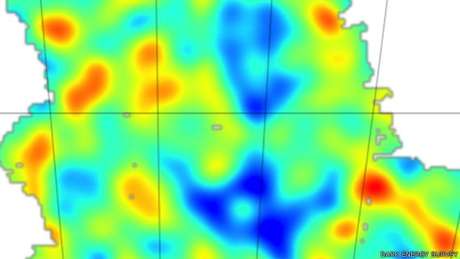It is the efforts of more than 200 scientists in six countries.
A map showing what seemed impossible to visualize, dark matter of the Universe.
The map was made by researchers of international project called Dark Energy Survey, DES, literally Mapping of Dark Energy.
Current theory holds that the kind of matter we know from ourselves to galaxies, is only about 4% of the universe . The rest is dark matter (about 20%) and dark energy (over 70%).
But what dark matter and how it differs from dark energy?
BBC spoke to one of the Spanish researchers involved in the project, Enrique Gaztañaga.
“We have clear evidence that most matter in the universe (about 80%) is not made of ordinary matter, such as forming atoms, stars or galaxies we observe. It is a new type of matter called dark matter, “he told BBC Gaztañaga, research professor at the Higher Council for Scientific Research at the Institute of Space Sciences of Barcelona (www.ice.cat).
The dark matter does not emit or absorb light, making it impossible to see directly.
But scientists know it exists by the effects caused by exerting gravitational pull on matter that we can see.
“We can measure how this dark matter is subject to the effects of gravity, attracting other bodies that are visible in our telescopes, but it itself is invisible (not emit light or interact electromagnetically). ”
An example of this effect is seen in spiral galaxies, which rotate faster than they should if the only matter that existed in them was visible.
Dark Energy
Dark energy is different and is the mysterious force that would be responsible for the accelerated expansion of the universe.
“The dark energy behaves like matter. When the universe the density of matter expands decreases (diluted as in a gas), while the density of dark energy remains constant, “said Gaztañaga.
“It’s like expanding the space miraculously appeared more energy. This is what happens when the vacuum has energy, which predicts the Heisenberg uncertainty principle of quantum mechanics” .
“The problem is to predict what this energy density. The theoretical models can not do it. Still, the accelerated expansion of the universe allows us to deduce that this dark energy exists and that has a positive value and represents between 70 and 75% of the energy of the cosmos “.
The problem is that the theoretical models predict not know which should be the vacuum energy density … not even clear which model to use, explained Gaztañaga.
“However, we can deduce its value from measurements of accelerated expansion, which indicates that it has a positive value and represents between 70 and 75% of all energy and matter in the cosmos. In the future we hope DES data to measure whether this density is really constant or not. ”
The researcher noted that the universe was “initially very homogeneous and boring”.
“The density was the same everywhere. Today the average density is very small (a few atoms per cubic meter) in most of the universe.”
“But there are areas, as our planet or our body where densities of matter are huge (1 followed by 30 zeros higher than average). How did this happen? How we have come to this? Without dark matter or dark energy could have no form galaxies, stars and planets that host life like ours. ”
Detecting the invisible
If dark matter can not be observed, how scientists can map their presence?
The project uses images of one of the most powerful digital cameras in the world.
The 570-megapixel camera, or DECam House of Dark Energy, is mounted on Victor M. Blanco telescope at Cerro Tololo Observatory in Chile.
great precision instruments are required to detect dark matter based on how it affects the light from distant galaxies.
“The camera is the most powerful in operation and allows mapping of galaxies about 20 times faster than previous cameras.”
The legacy of Einstein
Gazteñaga told BBC News that the map shows the distribution of all matter (including dark matter) projected in the sky.
“Einstein predicted that all power is subject to gravity and therefore light would also be attracted by matter. This prediction was confirmed in the famous experiment of the solar eclipse 1922, when he was the sun turned the light path of the stars passing near this during an eclipse (no eclipse not seen). This effect is called gravitational lensing. ”
The Spanish researcher said the map was obtained from the gravitational lens effect, studying the deformation of the images of the deepest galaxies.
“The maps show the distribution of matter and the scope and size of its fluctuations (the structures that give rise to galaxies and planets)”.
“is the largest contiguous map has been done to date. But it is only a small part of what we hope to do with the Dark Energy Survey in the next three years.”
Gaztañaga said it expects to map 30 times that will reveal the properties of cosmic expansion to within 1%.
“Why structures in the cosmos form”
The map was presented this week at a meeting of the American Physical Society and published in ArXiv, an online archive for preprints of scientific papers.
Gaztañaga expects the project and its tools help you “understand precisely how and why structures are formed in the cosmos.”
The map will include in the future eighth of the sky. The first data cover 0.4%.
What can you tell us the map in the future on dark energy?
“The distribution of fluctuations of matter can help us more accurately measure the expansion rate of the universe and also the rate of growth of these fluctuations,” Gaztañaga said.
“This will allow us to better understand dark energy, since this determines the expansion and growth.”
“Without this dark energy, we would not be here.”

No comments:
Post a Comment